
Greywater wetland piping and walls
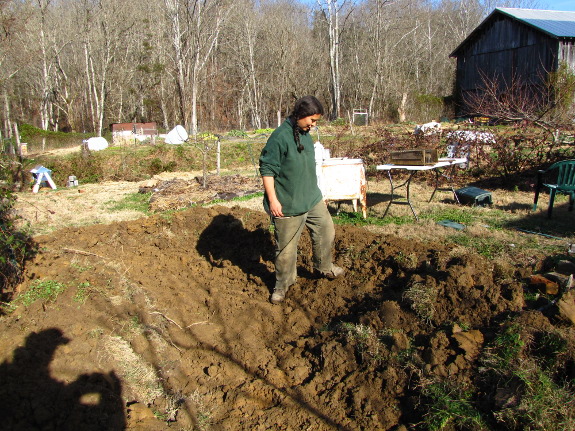
I did a little reading
and pondering overnight and decided to change the shape of my greywater
wetland a bit.
It was approximately three feet wide and twelve feet long at the end of
the day Wednesday, but Create
an Oasis With Greywater recommends a width twice the
length. The upper end of the wetland is hemmed in, but I opened
it out a few feet down to perhaps five feet wide, then stomped on the
walls until they became a more gentle (hopefully mowable) slope.
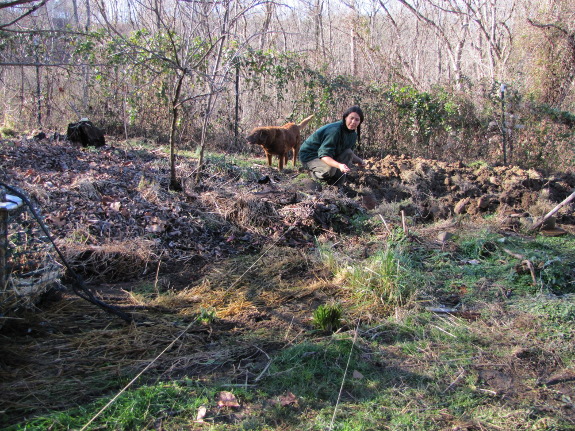
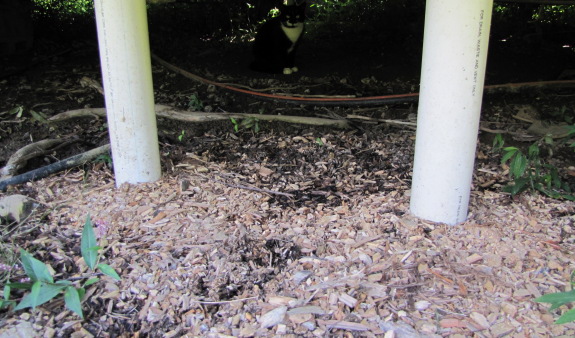 The
next step was to consider how the water is going to get to the
wetland. We currently have two 3" pipes
running straight down from our kitchen sink. Even though it will
cost more to run both of them all the way to the wetland, keeping our
fast drainage seemed worth the hassle. We'll be using unflexible
PVC pipes that won't curve, so I pulled out some string to make
straight lines between the current sink outlet and the inlet of the
wetland.
The
next step was to consider how the water is going to get to the
wetland. We currently have two 3" pipes
running straight down from our kitchen sink. Even though it will
cost more to run both of them all the way to the wetland, keeping our
fast drainage seemed worth the hassle. We'll be using unflexible
PVC pipes that won't curve, so I pulled out some string to make
straight lines between the current sink outlet and the inlet of the
wetland.
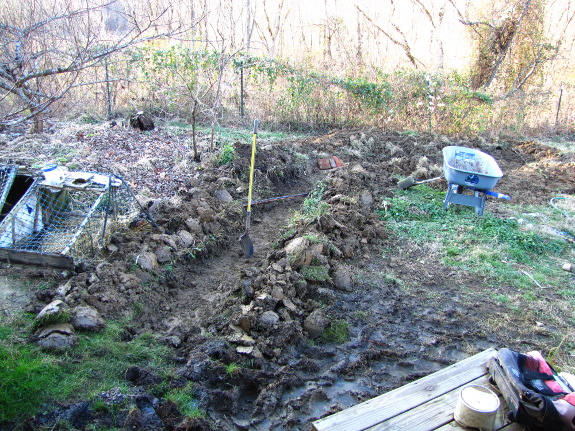
When Mark buried the
waterline, the
project was painful because we wanted to get the lines deep enough they
wouldn't freeze. In contrast, my greywater lines are only being
buried for convenience, so we won't trip over them and can easily mow
over the area. Freezing won't be a problem because the water will
run straight out into the wetland, so my trench is only barely deep
enough to get the pipes underground.
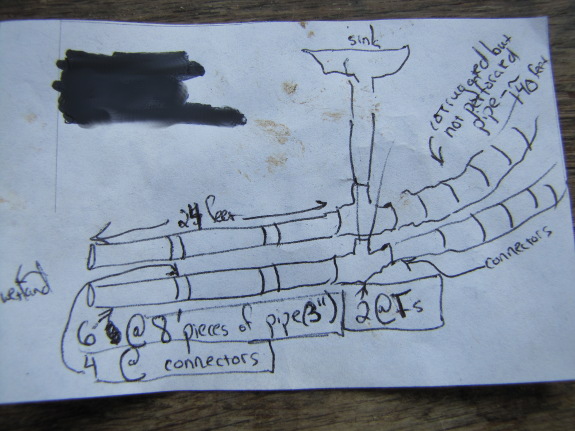
Here's Mark's shopping
list for today. We decided to make a T below the sink and let the
roof runoff come in there rather than running at third line for that
water. Heavy rains will hopefully flush out any gunk that may try
to build up in the lines between the sinks and the wetland.
I actually worked some
more on the inlet area of the wetland yesterday too, but this post is
already long enough, so I'll regale you with those details
tomorrow. Stay tuned!
Want more in-depth information? Browse through our books.
Or explore more posts by date or by subject.
About us: Anna Hess and Mark Hamilton spent over a decade living self-sufficiently in the mountains of Virginia before moving north to start over from scratch in the foothills of Ohio. They've experimented with permaculture, no-till gardening, trailersteading, home-based microbusinesses and much more, writing about their adventures in both blogs and books.
Want to be notified when new comments are posted on this page? Click on the RSS button after you add a comment to subscribe to the comment feed, or simply check the box beside "email replies to me" while writing your comment.

I have a question. In my permaculture course we were told that plumbing kitchen water into the graywater system was a bad idea-- mainly because of grease/oils and food stuff. Now I'm thinking that this was mainly advised for a system that ran entirely through pipes-- like irrigation lines-- to keep them from backing up. Since you've obviously been letting your kitchen water flow out for awhile, do you foresee any issues (besides potential buildup) with grease/oil/food bits going into the open wetland? Do you think it will break down quickly enough?
My first thought it that it might get smelly, but other than that I guess the problem with grease and oil is minimal in an open system.
I haven't read through the book you referred to, but I remember looking through some of the graywater ordinances in AZ that required the water to be out of human contact. In other words, the entire system would be rigged like an irrigation system and kept underground, or buried in gravel at least. This is based on the potential to come in contact with whatever bacteria gets concentrated in the system-- things like staph, or whatever. Some of the laws are pretty strict.
I suppose all of that effort isn't required in an unregulated backyard system. I'd be interested in hearing your thoughts on the open system if you have more time to talk about the kitchen drainage issues, potential contact, etc.
Gerry --- We decided against flexible pipe on the way from the sink to the wetland because we want to make sure it's really, really easy to flush solids all the way through. Not that I'm going to be stuffing carrot peelings down the drain, but I know food scraps inevitably will wash down, and I'd hate to have to dig up the line in a year to clean it out.
The slope out back there is right at 0.5%, which is barely enough, maybe, for what we're trying to do. That could be the weakest point, but I want to try it the easy way and then change it if necessary.
Sara --- Those are good questions. This system definitely wouldn't pass muster if you had to get it inspected (but I don't think any homemade greywater treatment systems are legal in most states). I don't particularly care about the legal issue because we can't even get the game warden to walk past our moat to get to our core homestead so I suspect the health inspector won't be coming by, but I do care about health issues and environmental issues.
In terms of health issues, kitchen waste is a bit "dirtier" than waste from a bathtub (but cleaner, of course, than blackwater from a toilet). Wetlands have been used to treat even blackwater, but if you go to that extreme, you want to take a lot of precautions to make sure nothing seeps into the groundwater, that you send the water through multiple wetlands to completely treat it, and that no one comes in contact with the waste water.
On the other hand, our current treatment of sink water is the most minimal treatment you can get, and it actually works pretty well. Minor issues include a muddy area right outside our back door, and a bit of anaerobic (swampy) odor now and then. I'd say it's about as much of a health hazard as a compost pile, which is to say none for people with a good immune system.
With that in mind, I figure our greywater wetland won't be any more of a problem. The wetland plants I'll be adding should help treat the water better than the current bits of grass growing in the overflow area, and we've moved it away from the back door so we won't be walking in mud. On the other hand, there are times when I wouldn't even recommend a greywater wetland like the one I'm building. For example, if you'd be unable to fence kids out of it, or if you have a dog that regularly licks you in the face and who can't be trained to stay out of the wetland, health issues would probably come up.
A final issue to consider is solids. We're planning the system to wash any solids all the way out to the wetland, with hopefully no places those wastes could collect. If we were trying to irrigate with the water, kitchen sink drainage would be trouble because of all those little bits of food clogging lines and then anaerobically decomposing in the pipes. I suspect that's where your instructor was coming from when recommending against using sink water in a greywater system.
Make sure you have a gradient on the pipes leading to the wetland. Normal gradient for a sewer pipe is 1/4"/12 for 3" pipe.
To precent smells and vermin entering your house, put a trap in the vertical pipe under the sink if you don't have one already.
Looks good! I love digging in the dirt and doing projects this time of year.
You may consider adding a clean-out so that you can snake the pipe easily. I'd put it between the "T" and the rain water collection and angle it towards the wetland. If some how the drain does get clogged the clean-out can allow water to escape there instead of trying to back up into the kitchen sink (if the rainwater collection point is higher than the sink this could be a potential problem.) This would require the clean-out to have some sort of flap instead of a screw on cover.
Roland --- Thanks for checking the slope. I'd meant to look it up, and it looks like we'll be fine with our 0.5% (which is 0.6 inches in twelve). That might leave some solids behind by flowing too fast, but probably not with the amount of water gushing through when we let out the sink water.
Daddy --- Definitely an excellent system! I considered something like that for us, but we get so much more rain than you (and our clay is so much more prone to waterlogging than your sand) that I figured I might kill the plants.
Brian --- Interesting idea with the cleanout. I like it, except that it would probably result in a mowing hazard. Hmmm....
Luckily, our rainwater collection point is lower than the kitchen sink, though, so excess water would probably spill out there instead the way it's currently designed.
If it were me, I would want to make it cleanable in one way or another. Either, as mentioned, a clean-out or forget the "T" and make a curve that a plumbing snake can wiggle by. I wonder do they make like a brush attachment for those snakes?
Also, I learned from all my studies @ HGTV that air must follow water in drainage. http://en.wikipedia.org/wiki/Drain-waste-vent_system
It sounds like you might have solved that already with the rainwater pipes? leading to the gutter?
As to the drain traps... I don't know. With sewer gas it's a must, but how stinky can those pipes really get? Maybe that could be a "its time to snake the pipes" notification.
Dirk --- Thanks for the reminder about the trap! Roland mentioned it and I somehow forgot to reply to that part of his comment. The author of Create an Oasis With Greywater wrote "Traps and vents are unnecessary if you gut all ties to the septic/sewer and do Radical Plumbing" (which is very much what we're doing). He does recommend a screen at the end of the pipe to keep critters from crawling back up through.
Actually, as I continue reading, it looks like we shouldn't need a separate cleanout either. "Code calls for a cleanout...ever 135 degrees of cumulative bend..." Our total is that one 90 degree angle in the T, so it looks like we'd be able to snake down that bend. Also, he adds the tip to flush the line with roof runoff like I'm talking about, but to make that connection easy to unhook so I can snake from the back end of the T there. You'd think I didn't thoroughly read this book the first time around from all the new points I'm noticing as I flip through it again.
A screen on the outlet is much more likely that a trap to clog up with grease and food remains and whatever else goes down the pipes.
Since these pipes also transport rainwater from the roof, your sink might fill back up and overflow if the outlet screen gets clogged and you have a big rainstorm!
We have a small wetland at the outlet of our sewage treatment tank. It's about 100 ft from the house and the vegetation is so thick that it's pretty good at keeping kids and animals out now.
The tank is supposed to process everything except nitrogen (when working correctly). The wetland is not a sophisticated tertiary treatment, but that's the idea-- to suck up the extra nitrogen. I've heard a bit about living wetlands that are used as a final "polishing" step, to soak up nutrients. My city uses one and it's controversial since it is diverted into a natural wetland, though I think the real issue of controversy is the artificially constant flow of water, not the type of water.
Anyway, our household plumbing is miserable. The tank is probably the best part of the system, so instead of focusing on that end, I probably just need to re-do the plumbing itself.
For my graywater entertainment, I suppose I'll just have to live vicariously through your blog